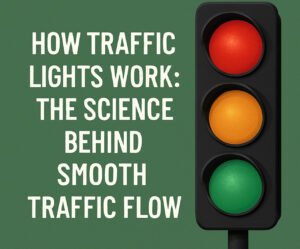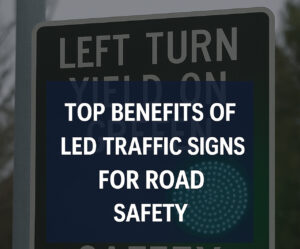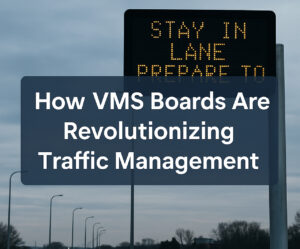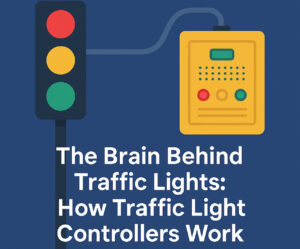As smart cities become reality, the technology that shapes our daily lives is evolving fast—even in places we might not expect. Take traffic signage, for example. From traffic signs for sale in online catalogs to construction traffic signs lining work zones, to the many forms of all traffic signs across highways and intersections, we’re witnessing a transformation. The future of traffic signs is smart, connected, and powered by IoT (Internet of Things) and AI (Artificial Intelligence). Know more..
The Need for Smarter Traffic Signs
Traditional traffic signs have done the job for decades: direct, warn, and inform. But they’re static. They can’t adapt to real-time situations like sudden weather changes, accidents, or traffic congestion. In an era of smart infrastructure, all traffic signs need to be more than reflective boards on poles.
Enter smart traffic signage: signs that talk to vehicles, update automatically, and learn from their environment. As more agencies seek construction traffic signs that offer real-time updates, or invest in advanced traffic signs for sale, IoT and AI become central players in the conversation.
What Is a Smart Traffic Sign?
Smart traffic signs are digital or enhanced traditional signs integrated with sensors, cameras, connectivity modules, and sometimes, dynamic displays. These systems communicate directly with:
- Traffic control centers
- Autonomous vehicles
- Emergency services
- Weather monitoring systems
They can adjust messages based on:
- Traffic density
- Accident alerts
- Speed monitoring
- Weather hazards
This takes all traffic signs to the next level—from passive instructions to proactive systems.
The Role of IoT in Traffic Sign Evolution
The Internet of Things connects physical devices to digital networks. When construction traffic signs are IoT-enabled, they can:
- Detect when a work zone is active or inactive
- Update speed limits in real-time
- Notify control centers of theft or damage
Cities are already experimenting with smart traffic signs for sale that include RFID tags, GPS modules, and solar-powered sensors. These features make it easier to manage signs remotely and ensure accurate communication.
Key IoT Advantages:
- Real-time sign status reporting
- Geolocation tracking
- Condition monitoring (tilt, damage, power loss)
By incorporating these tools, all traffic signs can be monitored and maintained more effectively.
How AI Enhances Smart Signage
AI transforms how signs process data. By pairing signs with cameras and computer vision, they can “see” and interpret:
- Traffic patterns
- Vehicle speeds
- Pedestrian behavior
An AI-enhanced construction traffic sign might detect when workers are present and automatically reduce speed limits. Or a digital warning sign could use AI to predict accidents based on historical data and suggest reroutes.
AI applications include:
- Adaptive messaging based on congestion
- Automatic rerouting instructions
- Predictive maintenance of signage
With AI in play, traffic signs for sale are no longer static tools; they become dynamic, learning systems.
Vehicle-to-Infrastructure (V2I) Communication
One of the most exciting parts of smart signs is V2I—when vehicles communicate directly with infrastructure. This is especially important for autonomous vehicles, which rely on constant data to navigate safely.
In the near future:
- A smart car might receive alerts from a construction traffic sign before it’s even visible.
- A sign could flash a warning to approaching vehicles if a pedestrian is detected in a crosswalk.
For anyone managing inventories of traffic signs for sale, this is a major shift in product expectations and standards.
Benefits for Cities and Drivers
Smarter all traffic signs offer real-world benefits that go beyond convenience:
1. Safety Improvements
- Reduce human error
- Respond instantly to hazards
- Adapt to driver behavior in real-time
2. Efficiency Gains
- Optimize traffic flow
- Support real-time detours and congestion control
- Coordinate with traffic lights and signals
3. Cost Savings
- Fewer workers needed to update signage manually
- Better resource allocation
- Lower accident rates and associated costs
Municipalities investing in smart traffic signs for sale will reap returns in safety, mobility, and public trust.
Challenges to Widespread Adoption
While the future is promising, there are still challenges:
- Cost: Advanced signs with AI and IoT features are more expensive than traditional ones.
- Standardization: Integrating different systems and technologies requires uniform protocols.
- Privacy: Camera-equipped signs must balance data collection with public privacy concerns.
- Durability: Smart signs must withstand outdoor environments while housing sensitive electronics.
Despite these hurdles, more cities are moving toward these technologies, and the market for smart construction traffic signs and connected signage is growing.
Real-World Examples in Action
- Barcelona, Spain: Piloted dynamic speed limit signs that change based on air quality and traffic conditions.
- Pittsburgh, USA: Uses AI-controlled traffic signals that adjust based on real-time traffic flows.
- Dubai, UAE: Developing a smart signage system that integrates with autonomous taxis and delivery drones.
Each of these cities is setting a standard for what future all traffic signs should achieve.
What This Means for the Industry
From local governments to traffic signs for sale distributors, everyone in the signage supply chain needs to prepare. That means:
- Upskilling to understand smart infrastructure
- Partnering with tech companies for sign development
- Stocking hybrid signs that can bridge traditional and smart applications
Construction traffic signs will increasingly require built-in sensors, solar power, and compatibility with municipal data systems.
Traffic barrel and sign manufacturers should expect demand to shift toward smart tech integration in the next five years.
Shopping Smart: How to Choose Future-Ready Signs
When browsing for traffic signs for sale, especially if you’re outfitting a construction firm or municipality, look for:
- Modular signs that allow tech upgrades
- Compatibility with sensors or lighting
- Strong visibility and weather-resistance
- Connectivity options (Bluetooth, LTE, WiFi)
Soon, every sign in your inventory—from construction traffic signs to permanent installations—may need to be digitally enhanced.
Final Thoughts: Signs That Think
We’re standing at a new frontier. All traffic signs will soon play a part in connected ecosystems that think, adapt, and respond. They’ll no longer be passive tools but active communicators in our daily drive.
From modern traffic signs for sale that link to central data hubs, to smart construction traffic signs that know when a work crew is active, the industry is heading toward a high-tech upgrade.
Cities that embrace these technologies early will lead the way in safety, efficiency, and innovation. The rest will catch up—and the signs will be pointing the way forward.





